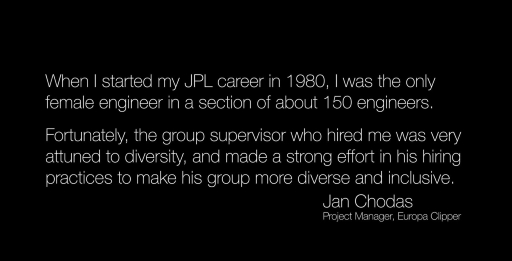3.3 Diversity and innovation
There is a significant body of evidence to support the fact that diverse teams are more innovative. Watch this short video from NASA’s Jet Propulsion Laboratory (JPL), which explains how their workforce has changed and the benefits that inclusion brings.

Transcript: Video 7: Inclusion Drives Innovation at JPL
[MUSIC PLAYING]
[TEXT ON SCREEN]: When I started my JPL career in 1980, I was the only female engineer in a section of about 150 engineers. Fortunately, the group supervisor who hired me was very attuned to diversity, and made a strong effort in his hiring practices to make his group more diverse and inclusive.
[MUSIC PLAYING]
In a recent career column in the scientific journal Nature, social scientist Katrin Prager (2021) describes how working with a team of individuals from a variety of demographic and disciplinary backgrounds ‘prompted us to look for insights in places that a less-diverse team would not even have considered.’
The author also goes on to highlight an issue that can impair this diversity when we are choosing who to work with on particular problems, and that is homophily, or ‘love of the same’.
You might have heard the proverb ‘birds of a feather flock together’. It basically means ‘people of similar interests, background, ideas or characteristics will often congregate or hang out with each other, people who have similar ideas or values tend to stick together’ (Grammarist, no date).
This can impair innovation, as similar people will have overlapping experience and knowledge and won’t challenge each other in the same way.
Over time, even a diverse organisation can become increasingly homogenised and fall into something known as ‘groupthink’, which reduces our ability to explore different solutions and identify our blind spots, preventing organisations from leveraging the power of their diversity. You’ll explore ‘groupthink’ in more detail in Week 8.
The advantages of friction
Being inclusive has numerous benefits but it is not always the most comfortable journey. Differences in ideas and perceptions can cause conflicts that many of us would prefer to avoid. It is important though to learn to be comfortable with the uncomfortable. You’ll explore conflict in more detail in Week 4.
Cross (2022) describes several reasons why we need friction in the workplace to build a culture of innovation:
- Friction is where we have to unpack and explore our ideas more deeply, so we can better explain them to others.
- Friction is where ideas, perspectives and assumptions are tested.
- Friction is where we can create a culture in which everybody feels safe to constructively disagree.
- Friction is where we grow through exposure to new ways of thinking.
In her article in Nature, Prager (2021) also goes on to describe the cognitive challenge involved in collaborating within diverse teams as members must often overcome differences in vocabulary, knowledge and understanding. She gives an example from her own experience of working with a researcher from Brazil and gradually realising they both had a very different understanding of the word ‘community’, but also describes the benefits of combining their understanding to bring greater insight.
For organisational leaders, another positive aspect of diversity is its potential impact on profitability.
